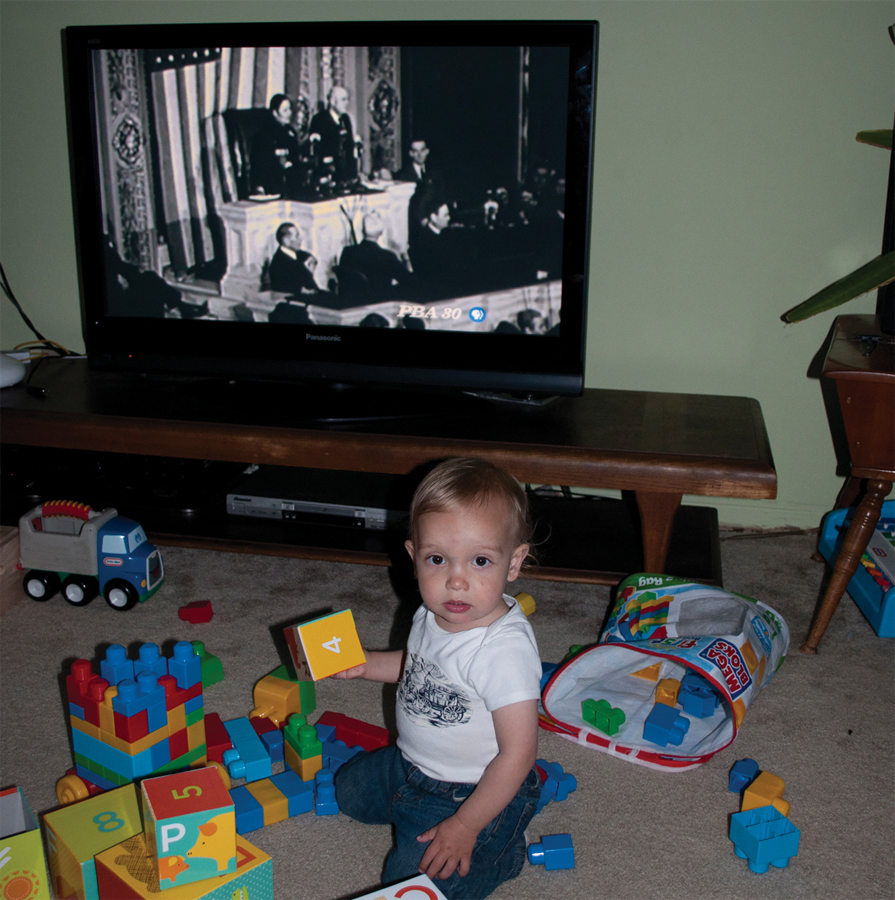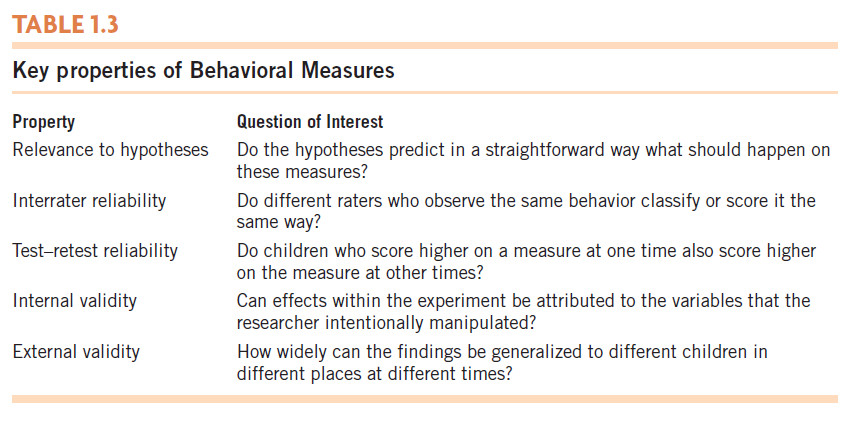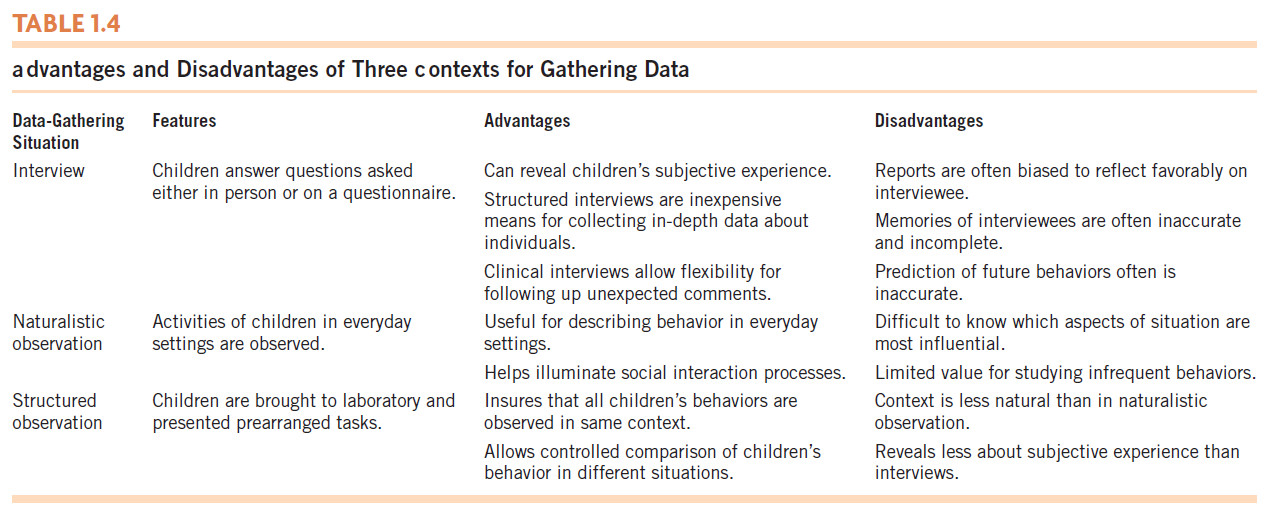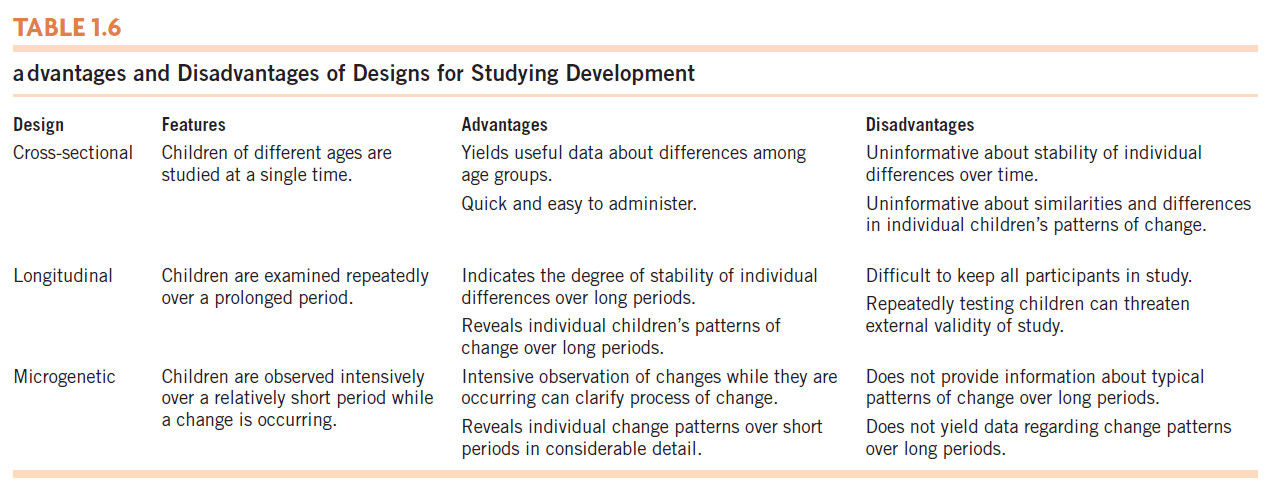Methods for Studying Child Development
As illustrated in the preceding section, modern scientific research has advanced the understanding of fundamental questions about child development well beyond that of the historical figures who first raised the questions. This progress reflects the successful application of the scientific method to the study of child development. In this section, we describe the scientific method and examine how its use has advanced understanding of child development.
23
The Scientific Method
scientific method an approach to testing beliefs that involves choosing a question, formulating a hypothesis, testing the hypothesis, and drawing a conclusion
The basic assumption of the scientific method is that all beliefs, no matter how probable they seem and no matter how many people share them, may be wrong. Therefore, until beliefs have been tested, they must be viewed as hypotheses, that is, as educated guesses, rather than as truth. If a hypothesis is tested, and the evidence repeatedly does not support it, the hypothesis must be abandoned no matter how reasonable it seems.
hypotheses educated guesses
Use of the scientific method involves four basic steps:
- Choosing a question to be answered
- Formulating a hypothesis regarding the question
- Developing a method for testing the hypothesis
- Using the data yielded by the method to draw a conclusion regarding the hypothesis
To illustrate these steps, let’s make the question to be answered “What abilities predict which children will become good readers?” A reasonable hypothesis might be “Kindergartners who can identify the separate sounds within words will become better readers than those who cannot.” A straightforward method for testing this hypothesis would be to select a group of preschoolers, test their ability to identify the separate sounds within words, and then, several years later, test the reading skills of the same children. Research has, in fact, shown that kindergartners who are aware of the component sounds within words later tend to read more skillfully than their peers who lacked this ability as kindergartners. This pattern holds true regardless of whether the children live in the United States, Australia, Norway, or Sweden (Furnes & Samuelsson, 2011). These results support the conclusion that kindergartners’ ability to identify sounds within words predicts their later reading skill.
The first, second, and fourth of these steps are not unique to the scientific method. As we have seen, great thinkers of the past also asked questions, formulated hypotheses, and drew conclusions that were reasonable given the evidence available to them. What distinguishes scientific research from nonscientific approaches is the third step: the methods used to test the hypotheses. When rigorously employed, these research methods yield high-quality evidence that allows investigators to progress beyond their initial hypotheses to draw firmly grounded conclusions.
The Importance of Appropriate Measurement
For the scientific method to work, researchers must use measures that are directly relevant to the hypotheses being tested. Even measures that initially seem reasonable sometimes turn out to be less informative than originally thought. For example, a researcher who hypothesized that a supplemental food program would help children suffering from malnutrition might evaluate the program on the basis of weight gain from just before the program to just after it. However, weight is an inadequate measure of nutrition: Providing unlimited supplies of Cheetos would probably produce weight gain but not improve nutrition, and many people are obese yet malnourished (Sawaya et al., 1995). Better measures of nutrition would include whether more adequate levels of essential nutrients were present in the children’s bloodstreams at the end of the study (Shetty, 2006).
24
Regardless of the particular measure used, many of the same criteria determine whether a measure is a good one. One key criterion has already been noted—the measure must be directly relevant to the hypothesis. Two other qualities that good measures must possess are reliability and validity.
reliability the degree to which independent measurements of a given behavior are consistent
interrater reliability the amount of agreement in the observations of different raters who witness the same behavior
Reliability The degree to which independent measurements of a behavior under study are consistent is referred to as reliability. One important type of consistency, interrater reliability, indicates how much agreement there is in the observations of different raters who witness the same behavior. Sometimes the observations are qualitative, as when raters classify a baby’s attachment to her mother as “secure” or “insecure.” Other times the observations are quantitative, as when raters score on a scale of 1 to 10 how upset babies become when they are presented with an unfamiliar noisy toy or a boisterous stranger. In both cases, interrater reliability is attained when the raters’ observations are in close agreement—as when, for example, Baby A in a group being observed for a particular behavior gets a 6 or 7 from all the raters, Baby B gets a 3 or 4, Baby C gets an 8 or 9, and so on. Without such close agreement, one cannot have confidence in the research findings, because there is no way to tell which (if any) rating was accurate.
test–retest reliability the degree of similarity of a child’s performance on two or more occasions
A second important type of consistency is test-retest reliability. This type of reliability is attained when measures of a child’s performance on the same test, administered under the same conditions, are similar on two or more occasions. Suppose, for example, that researchers presented a vocabulary test to a group of children on two occasions one week apart. If the test is reliable, those children who scored highest on the first testing should also score highest on the second, because none of the children’s vocabularies would have changed much over such a short period. As in the example of interrater reliability, a lack of test–retest reliability would make it impossible to know which result (if either) accurately reflected each child’s status.
validity the degree to which a test measures what it is intended to measure
internal validity the degree to which effects observed within experiments can be attributed to the factor that the researcher is testing
Validity The validity of a test or experiment refers to the degree to which it measures what it is intended to measure. Researchers strive for two types of validity: internal and external. Internal validity refers to whether effects observed within experiments can be attributed with confidence to the factor that the researcher is testing. For example, suppose that a researcher tests the effectiveness of a type of psychotherapy for depression by administering it to a number of depressed adolescents. If three months later many of the adolescents are no longer depressed, can it be concluded that this type of psychotherapy caused the improvement? No, because the students’ recovery may have been due to the mere passage of time. Moods fluctuate, and many adolescents who are depressed at any given time will be happier at a later date even without psychotherapy. In this example, the passage of time is a source of internal invalidity, because the factor believed to cause the improvement (the psychotherapy) may have had no effect.
external validity the degree to which results can be generalized beyond the particulars of the research
External validity, in contrast, refers to the ability to generalize research findings beyond the particulars of the research in question. Studies of child development are almost never intended to apply only to the particular children and research methods involved in a given study. Rather, the goal is to draw conclusions that apply to children more generally. Thus, the findings of a single experiment are only the first step in determining the external validity of the results. Additional studies with participants from different backgrounds and with different research methods are invariably needed to establish the external validity of the findings. (Table 1.3 summarizes the key properties of behavioral measures.)
25
Contexts for Gathering Data About Children
Researchers obtain data about children in three main contexts: interviews, naturalistic observation, and structured observation. In the following sections, we consider how gathering data in each context can help answer different questions about children.
Interviews
structured interview a research procedure in which all participants are asked to answer the same questions
The most obvious way to collect data about children is to go straight to the source and ask the children themselves about their lives. One type of interview, the structured interview, is especially useful when the goal is to collect self-reports on the same topics from everyone being studied. For example, Valeski and Stipek (2001) asked kindergartners and 1st-graders questions regarding their feelings about school (How much does your teacher care about you? How do you feel when you’re at school?) and also questions about their beliefs about their academic competence (How much do you know about numbers? How good are you at reading?). The children’s general attitude toward school and their feelings about their relationship with their teacher proved to be positively related to their beliefs about their competence in math and reading. Asking large numbers of children identical questions about their feelings and beliefs provides a quick and straightforward way for researchers to learn about children’s beliefs and attitudes.

clinical interview a procedure in which questions are adjusted in accord with the answers the interviewee provides
A second type of interview, the clinical interview, is especially useful for obtaining in-depth information about an individual child. In this approach, the interviewer begins with a set of prepared questions, but if the child says something intriguing, the interviewer can depart from the script to follow up on the child’s lead.
26
The usefulness of clinical interviews can be seen in the case of Bobby, a 10-year-old child who was assessed for symptoms of depression (Schwartz & Johnson, 1985). When the interviewer asked him about school, Bobby said that he did not like it because the other children disliked him and he was bad at sports. As he put it, “I’m not really very good at anything” (p. 214). To explore the source of this sad self-description, the interviewer asked Bobby what he would wish for if three wishes could be granted. Bobby replied, “I would wish that I was the type of boy my mother and father want, I would wish that I could have friends, and I would wish that I wouldn’t feel sad so much” (p. 214). Such heartrending comments provide a sense of the painful subjective experience of this depressed child, one that would be impossible to obtain from methods that were not tailored to the individual.
As with all contexts for collecting data, interviews have both strengths and weaknesses. On the positive side, they yield a great deal of data quickly and can provide in-depth information about individual children. On the negative side, answers to interview questions often are biased. Children (like adults) often avoid disclosing facts that show them in a bad light, distort the way that events happened, and fail to understand their own motivations (Wilson & Dunn, 2004). These limitations have led many researchers to use observational methods that allow them to witness the behavior of interest for themselves.
Naturalistic Observation
naturalistic observation examination of ongoing behavior in an environment not controlled by the researcher
When the primary research goal is to describe how children behave in their usual environments—homes, schools, playgrounds, and so on—naturalistic observation is the method of choice for gathering data. In this approach, observers try to remain unobtrusively in the background in the chosen setting, allowing them to see the relevant behaviors while minimizing the chances that their presence will influence those behaviors.
A classic example of naturalistic observation is Gerald Patterson’s (1982) comparative study of family dynamics in “troubled” and “typical” families. The troubled families were defined by the presence of at least one child who had been labeled “out of control” and referred for treatment by a school, court, or mental health professional. The typical families were defined by the fact that none of the children in them showed signs of serious behavioral difficulties. Income levels and children’s ages were the same for the troubled and typical families.

To observe the frequency with which children and parents engaged in negative behaviors—teasing, yelling, whining, criticizing, and so on—research assistants repeatedly observed dinnertime interactions in both troubled and typical homes. To accustom family members to his or her presence, the research assistant for each family made several home visits before beginning to collect data.
The researchers found that the behaviors and attitudes of both parents and children in the troubled families differed strikingly from those of their counterparts in the typical families. Parents in the troubled families were more self-absorbed and less responsive to their children than were parents in the typical households. Children in the troubled families responded to parental punishment by becoming more aggressive, whereas children in the typical households responded to punishment by becoming less aggressive. In the troubled families, interactions often fell into a vicious cycle in which:
27
- The child acted in a hostile or aggressive manner, for example, by defying a parent’s request to clean up his or her room.
- The parent reacted angrily, for example, by shouting at the child to obey.
- The child escalated the level of hostility, for example, by yelling back.
- The parent ratcheted up the aggression even further, perhaps by spanking the child.
As Patterson’s study suggests, naturalistic observations are particularly useful for illuminating everyday social interactions, such as those between children and parents.
Although naturalistic observation can yield detailed information about certain aspects of children’s everyday lives, it also has important limitations. One is that naturally occurring contexts vary on many dimensions, so it is often hard to know which ones influenced the behavior of interest. For example, it was clear in the Patterson study that the interactions of troubled families differed from those of the more harmonious families, but the interactions and family histories differed in so many ways that it was impossible to specify their contributions to the current situation. A second limitation of naturalistic studies is that many behaviors of interest occur only occasionally in the everyday environment, which reduces researchers’ opportunities to learn about them. A means for overcoming both limitations is the method known as structured observation.
Structured Observation
structured observation a method that involves presenting an identical situation to each child and recording the child’s behavior
When using structured observation, researchers design a situation that will elicit behavior that is relevant to a hypothesis and then observe how different children behave in that situation. The researchers then relate the observed behaviors to characteristics of the child, such as age, sex, or personality, and to the child’s behavior in other situations that are also observed.

In one such study, Kochanska, Coy, and Murray (2001) investigated the links between 2- and 3-year-olds’ compliance with their mother’s requests to forego appealing activities and their compliance with her requests that they participate in unappealing ones. Mothers brought their toddlers to a laboratory room that had a number of especially attractive toys sitting on a shelf and a great many less attractive toys scattered around the room. The experimenter asked each mother to tell her child that he or she could play with any of the toys except the ones on the shelf. Raters observed the children through a one-way mirror over the next few minutes and classified them as complying with their mother’s request wholeheartedly, grudgingly, or not at all. Then the experimenter asked the mother to leave the room and observed whether the child played with the “forbidden” toys in the mother’s absence.
The researchers found that children who had complied wholeheartedly in the first instance tended to avoid playing with the forbidden toys for a longer time in the second. Moreover, these children were also more likely to comply with their mother’s request that they put away the many toys on the floor after she left the room. When retested near their 4th birthday, most children showed the same type of compliance as they had as toddlers. Overall, the results indicated that the quality of young children’s compliance with their mother’s requests is a somewhat stable, general property of the mother–child relationship.
28
This type of structured observation offers an important advantage over naturalistic observation: it ensures that all the children being studied encounter identical situations. This allows direct comparisons of different children’s behavior in a given situation and, as in the research just discussed, also makes it possible to establish the generality of each child’s behavior across different tasks. On the other hand, structured observation does not provide as extensive information about individual children’s subjective experience as do interviews, nor can it provide the open-ended, everyday kind of data that naturalistic observation can yield.
As these examples suggest, which data-gathering approach is best depends on the goals of the research. (Table 1.4 summarizes the advantages and disadvantages of interviews, naturalistic observation, and structured observation as contexts for gathering data.)
Correlation and Causation
variables attributes that vary across individuals and situations, such as age, sex, and popularity
People differ along an infinite number of variables, that is, attributes that vary across individuals and situations, such as age, sex, activity level, socioeconomic status, particular experiences, and so on. A major goal of child-development research is to determine how these and other major variables are related to one another, both in terms of associations and in terms of cause–effect relations. In the following sections, we consider the research designs that are used to examine each type of relation.
Correlational Designs
correlational designs studies intended to indicate how two variables are related to each other
The primary goal of studies that use correlational designs is to determine whether children who differ in one variable also differ in predictable ways in other variables. For example, a researcher might examine whether toddlers’ aggressiveness is related to the number of hours they spend in day care or whether adolescents’ popularity is related to their self-control.
29
correlation the association between two variables
The association between two variables is known as their correlation. When variables are strongly correlated, knowing a child’s score on either variable allows accurate prediction of the child’s score on the other. For example, the fact that the number of hours per week that children spend reading correlates highly with their reading-test scores (Guthrie et al., 1999) means that a child’s reading-test score can be accurately predicted if one knows how much time the child spends reading. It also means that the number of hours the child spends reading can be predicted if one knows the child’s reading-test score.
Correlations range from 1.00, the strongest positive correlation, to -1.00, the strongest negative correlation. The direction is positive when high values of one variable are associated with high values of the other and low values of one are associated with low values of the other; the direction is negative when high values of one are associated with low values of the other. Thus, the correlation between time spent reading and reading-test scores is positive, because children who spend high amounts of time reading also have high reading-test scores; the correlation between obesity and running speed is negative, because the more obese the child, the slower his or her running speed. (For a more in-depth discussion of how correlations work, see the Appendix.)
Correlation Does Not Equal Causation
direction-of-causation problem the concept that a correlation between two variables does not indicate which, if either, variable is the cause of the other
When two variables are strongly correlated and there is a plausible cause–effect relation between them, it often is tempting to infer that one causes the other. However, this inference is not justified, for two reasons. The first is the direction-of-causation problem: a correlation does not indicate which variable is the cause and which variable is the effect. In the above example of the correlation between time spent reading and reading achievement, greater time spent reading might cause increased reading achievement. On the other hand, the cause–effect relation could run in the opposite direction: greater reading skill might cause children to spend more time reading, because reading faster and with greater comprehension makes reading more enjoyable.
third-variable problem the concept that a correlation between two variables may stem from both being influenced by some third variable
The second reason that correlation does not imply causation is the third-variable problem: the correlation between two variables may actually be the result of some third, unspecified variable. In the reading example, for instance, rather than greater reading achievement being caused by greater reading time, or vice versa, both of these aspects of reading could be caused by growing up in a family that values knowledge and intelligence.
Recognizing that correlation does not imply causation is crucial for interpreting accounts of research. Even findings published in prestigious research journals can easily be misinterpreted. For example, based on a correlation between children younger than 2 years sleeping with a night-light and their later becoming nearsighted, an article in the prestigious journal Nature concluded that the light was harmful to visual development (Quinn et al., 1999). Not surprisingly, the claim received considerable publicity in the popular media (e.g., Torassa, 2000). Subsequent research, however, showed that the inference about causation was wrong. What actually seems to have happened is that the nearsighted infants generally had nearsighted parents, and the nearsighted parents, for unknown reasons, more often placed nightlights in their infants’ rooms (Gwiazda et al., 2000; Zadnik et al., 2000). As the example illustrates, even seemingly straightforward inferences of causation, based on correlational evidence, frequently prove to be wrong.
30
If correlation does not imply causation, why do researchers often use correlational designs? One major reason is that the influence of many variables of great interest—age, sex, race, and social class among them—cannot be studied experimentally (see the next section) because researchers cannot manipulate them; that is, they cannot assign participants to one sex or another, to one SES or another, and so on. Consequently, these variables can only be studied through correlational methods. Correlational designs are also of great use when the goal is to describe relations among variables rather than to identify cause–effect relations among them. If, for example, the research goal is to discover how moral reasoning, empathy, anxiety, and popularity are related to one another, correlational designs would almost certainly be employed.
Experimental Designs
experimental designs a group of approaches that allow inferences about causes and effects to be drawn
If correlational designs are insufficient to indicate cause–effect relations, what type of approach is sufficient? The answer is experimental designs. The logic of experimental designs can be summarized quite simply: If children in one group are exposed to a particular experience and subsequently behave differently from a comparable group of children who were not exposed to the experience or were exposed to a different experience, then the subsequent differences in behavior must have resulted from the differences in experience.
random assignment a procedure in which each child has an equal chance of being assigned to each group within an experiment
Two techniques are crucial to experimental designs: random assignment of participants to groups, and experimental control. Random assignment involves assigning the participants to one experimental group or another according to chance so that the groups are comparable at the outset. This comparability is crucial for being able to infer that it was the varying experiences to which the groups were exposed in the experiment that caused the later differences between them. Otherwise, those differences might have arisen from some preexisting difference between the people in the groups.
Say, for example, that researchers wanted to compare the effectiveness of two interventions for helping depressed mothers improve their relationship with their infant—providing the mothers with home visits from trained therapists versus providing them with supportive phone calls from such therapists. If the researchers provided the home visits to families in one neighborhood and the supportive phone calls to families in another neighborhood, it would be unclear whether any differences in mother–infant relationships following the experiment were caused by differences between the effectiveness of the two types of support or by differences between the families in the two areas. Depressed mothers in one neighborhood might suffer from less severe forms of depression than mothers in the other, or they might have greater access to other support, such as close families, mental health centers, or parenting programs.

experimental control the ability of researchers to determine the specific experiences that children have during the course of an experiment
experimental group a group of children in an experimental design who are presented the experience of interest
In contrast, when groups are created through random assignment and include a reasonably large number of participants (typically 20 or more per group), initial differences between the groups tend to be minimal. For example, if 40 families with mothers who suffer from depression are divided randomly into two experimental groups, each group is likely to have roughly equal numbers of families from each neighborhood. Similarly, each group is likely to include a few mothers who are extremely depressed, a few with mild forms of depression, and many in between, as well as a few infants who have been severely affected by their mother’s depression, a few who have been minimally affected, and many in between. The logic implies that groups created through random assignment should be comparable on all variables except the different treatment that people in the experimental groups encounter during the experiment. Such an experiment was in fact conducted, and it showed that home visits helped depressed mothers more than supportive phone calls did (Van Doesum et al., 2008).
31
control group the group of children in an experimental design who are not presented the experience of interest but in other ways are treated similarly
The second essential characteristic of an experimental design, experimental control, refers to the ability of the researcher to determine the specific experiences that children in each group encounter during the study. In the simplest experimental design, one with two conditions, the groups are often referred to as the “experimental group” and the “control group.” Children in the experimental group are presented with the experience of interest; children in the control group are treated identically except that they are not presented with the experience of interest or are presented with a different experience that is expected to have less effect on the variables being tested.
independent variable the experience that children in the experimental group receive and that children in the control group do not receive
dependent variable a behavior that is measured to determine whether it is affected by exposure to the independent variable
The experience that children in the experimental group receive, and that children in the control group do not receive, is referred to as the independent variable. The behavior that is hypothesized to be affected by exposure to the independent variable is referred to as the dependent variable. Thus, if a researcher hypothesized that showing schoolchildren an anti-bullying film would reduce school bullying, the researcher might randomly assign some children in a school to view the film and other children in the same school to view a film about a different topic. In this case, the anti-bullying film would be the independent variable, and the amount of bullying after the children watched it would be the dependent variable. If the independent variable had the predicted effect, children who saw the anti-bullying film would show less bullying after watching it than children who saw the other film.

One illustration of how experimental designs allow researchers to draw conclusions about causes and effects is a study that tested the hypothesis that television shows running in the background lower the quality of infants’ and toddlers’ play (Schmidt et al., 2008). The independent variable was whether or not a television program was on in the room where the participants were playing; the dependent variables were a variety of measures of children’s attention to the television program and of the quality of their play. The television program that was playing was Jeopardy!, which presumably would have been of little interest to the 1- and 2-year-olds in the study; indeed, they looked at it an average of only once per minute and only for a few seconds at a time. Nonetheless, the television show disrupted the children’s play, reducing the length of play episodes and the children’s focus on their play. These findings indicate that there is a causal, and negative, relation between background exposure to television shows and the quality of young children’s play.
Experimental designs are the method of choice for establishing causal relations, a central goal of scientific research. However, as noted earlier, experimental designs cannot be applied to all issues of interest. For example, hypotheses about why boys tend to be more physically aggressive than girls cannot be tested experimentally because gender cannot be randomly assigned to children. In addition, many experimental studies are conducted in laboratory settings; this improves experimental control but can raise doubts about the external validity of the findings, that is, whether the findings from the lab apply to the outside world. (The advantages and disadvantages of correlational and experimental designs are summarized in Table 1.5.)
32
Designs for Examining Development
A great deal of research on child development focuses on the ways in which children change or remain the same as they grow older and gain experience. To study development over time, investigators use three types of research designs: cross-sectional, longitudinal, and microgenetic.
Cross-Sectional Designs
cross-sectional design a research method in which children of different ages are compared on a given behavior or characteristic over a short period
The most common and easiest way to study changes and continuities with age is to use the cross-sectional approach. This method compares children of different ages on a given behavior, ability, or characteristic, with all the children being studied at roughly the same time—for example, within the same month. In one cross-sectional study, Evans, Xu, and Lee (2011) examined the development of lying in Chinese 3-, 4-, and 5-year-olds. The children played a game in which, to win a prize, they needed to guess the type of object hidden under an upside-down paper cup. However, before the child could guess, the experimenter left the room after telling the child not to peek while she was gone. The cup was so fully packed with candies that if the child peeked, some would spill out and it would be virtually impossible for the child to put them all back under the cup.
At all ages, many children peeked and then denied doing so. However, 5-year-olds lied more often, and their lies were cleverer. For example, many 5-year-olds explained away the presence of candies on the table by saying that they accidentally knocked over the cup with their elbow; other 5-year-olds destroyed the evidence by eating it. Three-year-olds were the least-skilled fibbers, generating implausible excuses such as that some other child entered the room and knocked over the cup or that the candies came out by themselves.
33
Cross-sectional designs are useful for revealing similarities and differences between older and younger children. However, they do not yield information about the stability of behavior over time or about the patterns of change shown by individual children. This is where longitudinal approaches are especially valuable.
Longitudinal Designs
longitudinal design a method of study in which the same children are studied twice or more over a substantial length of time
The longitudinal approach involves following a group of children over a substantial period (usually at least a year) and observing changes and continuities in these children’s development at regular intervals during that time. In one longitudinal study, Brendgen and colleagues (2001) examined children’s popularity with classmates each year from the time they were 7-year-olds to the time they were 12-year-olds. The popularity of most children proved to be quite stable over this period; a substantial number of children were popular in the large majority of years, and quite a few others were unpopular throughout. At the same time, some individuals showed idiosyncratic patterns of change from year to year; the same child might be popular at age 8, unpopular at age 10, and of average popularity at age 12. Such findings about the stability of individual differences over time and about individual children’s patterns of change could only have been obtained in a longitudinal design.

If longitudinal designs are so useful for revealing stability and change over time, why are cross-sectional designs more common? The reasons are mainly practical. Studying the same children over long periods involves the difficult task of locating the children for each re-examination. Inevitably, some of the children move away or stop participating for other reasons. Such loss of participants may call into question the validity of the findings, because the children who do not continue may differ from those who participate throughout. Another threat to the validity of longitudinal designs is the possible effects of the repeated testing. For example, repeatedly taking IQ tests could familiarize children with the type of items on the tests, thus improving the children’s scores. For these reasons, longitudinal designs are used primarily when the main issues are stability and change in individual children over time—issues that can be studied only longitudinally. When the central developmental issue involves age-related changes in typical performance, cross-sectional studies are more commonly used.
Microgenetic Designs
microgenetic design a method of study in which the same children are studied repeatedly over a short period
An important limitation of both cross-sectional and longitudinal designs is that they provide only a broad outline of the process of change. Microgenetic designs, in contrast, are specifically designed to provide an in-depth depiction of the processes that produce change (Miller & Coyle, 1999; Siegler, 2006). The basic idea of this approach is to recruit children who are thought to be on the verge of an important developmental change, heighten their exposure to the type of experience that is believed to produce the change, and then intensively study the change as it is occurring. Microgenetic designs are like longitudinal ones in repeatedly testing the same children over time. They differ in that microgenetic studies typically include a greater number of sessions presented over a shorter time than in a longitudinal study.
34
counting-on strategy counting up from the larger addend the number of times indicated by the smaller addend
Siegler and Jenkins (1989) used a microgenetic design to study how young children discover the counting-on strategy for adding two small numbers. This strategy involves counting up from the larger addend the number of times indicated by the smaller addend; for example, when asked the answer to 3 + 5, a child who was counting-on would start from the addend 5 and say or think “6, 7, 8” before answering “8.” Prior to discovering this strategy, children usually solve addition problems by counting from 1. Counting from the larger addend rather than from 1 reduces the amount of counting, producing faster and more accurate solutions.
To observe the discovery process, the researchers selected 4- and 5-year-olds who did not yet use counting-on but who knew how to add by counting from 1. Over an 11-week period, these children received many addition problems—far more than they would normally encounter before entering school—and each child’s behavior was videotaped for every problem. This approach allowed the researchers to identify exactly when each child discovered the counting-on strategy.

Examination of the problems immediately preceding the discovery revealed a surprising fact: necessity is not always the mother of invention. Quite a few children discovered the counting-on strategy while working on easy problems that they previously had solved correctly by counting from 1.
The microgenetic method also revealed that children’s very first use of the new strategy often was accompanied by insight and excitement, like that shown by Lauren:
Experimenter: How much is 6 + 3?
Lauren: (long pause) 9.
E: OK, how did you know that?
L: I think I said…I think I said…oops, um…7 was 1, 8 was 2, 9 was 3.
E: How did you know to do that? Why didn’t you count 1, 2, 3, 4, 5, 6, 7, 8, 9?
L: (with excitement) ’Cause then you have to count all those numbers.
(Siegler & Jenkins, 1989, p. 66)
Despite her insightful explanation of counting-on and her excitement over discovering it, Lauren, and most other children, only gradually increased their use of the new strategy on subsequent problems. Many other microgenetic studies have also shown that generalization of new strategies tends to be slow (Kuhn & Franklin, 2006).
As this example illustrates, microgenetic methods provide insight into the process of change over brief periods. However, unlike standard longitudinal methods, microgenetic designs do not yield information about stability and change over long periods. They therefore are typically used when the basic pattern of age-related change has already been established and the goal becomes to understand how the changes occur. (Table 1.6 outlines the strengths and weaknesses of the three approaches to studying changes with age and experience: cross-sectional, longitudinal, and microgenetic designs.)
35
Ethical Issues in Child-Development Research
All research with human beings raises ethical issues, and this is especially the case when the research involves children. Researchers have a vital responsibility to anticipate potential risks that the children in their studies may encounter, to minimize such risks, and to make sure that the benefits of the research outweigh any potential harm.
The Society for Research on Child Development, an organization devoted to research on children, has formulated a code of ethical conduct for investigators to follow (SRCD Governing Council, 2007). Some of the most important ethical principles in the code are:
- Be sure that the research does not harm children physically or psychologically.
- Obtain informed consent for participating in the research, preferably in writing, from parents or other responsible adults and also from children if they are old enough that the research can be explained to them. The experimenter should inform children and relevant adults of all aspects of the research that might influence their willingness to participate and should explain that refusing to participate will not result in any adverse consequences to them.
- Preserve individual participants’ anonymity, and do not use information for purposes other than that for which permission was given.
- Discuss with parents or guardians any information yielded by the investigation that is important for the child’s welfare.
- Try to counteract any unforeseen negative consequences that arise during the research.
- Correct any inaccurate impressions that the child may develop in the course of the study. When the research has been completed, explain the main findings to participants at a level they can understand.
Recognizing the importance of such ethical issues, universities and governmental agencies have established institutional review boards made up of independent scientists and sometimes others from the community. These boards evaluate the proposed research to ensure that it does not violate ethics guidelines. However, the individual investigator is in the best position to anticipate potential problems and bears the ultimate responsibility for seeing that his or her study meets high ethical standards.
36
review:
The scientific method, in which all hypotheses are treated as potentially incorrect, has allowed contemporary understanding of child development to progress well beyond the understanding of even the greatest thinkers of the past. This progress has been built on a base of four types of innovations:
- Measures that are directly relevant to the main hypotheses of the study
- Data-gathering situations that yield useful information about children’s behavior, such as interviews, naturalistic observations, and structured observations
- Designs that allow identification of associations and cause–effect relations among variables, notably correlational and experimental designs
- Designs that allow analysis of the continuities and changes that occur with age and experience, notably cross-sectional, longitudinal, and microgenetic designs
Conducting scientific experiments also requires meeting high ethical standards, including not in any way harming the children who participate; obtaining informed consent for their participation in the research; preserving anonymity of all participants; and, after the study, explaining the findings to parents and, when possible, to children, at a level they can understand.



